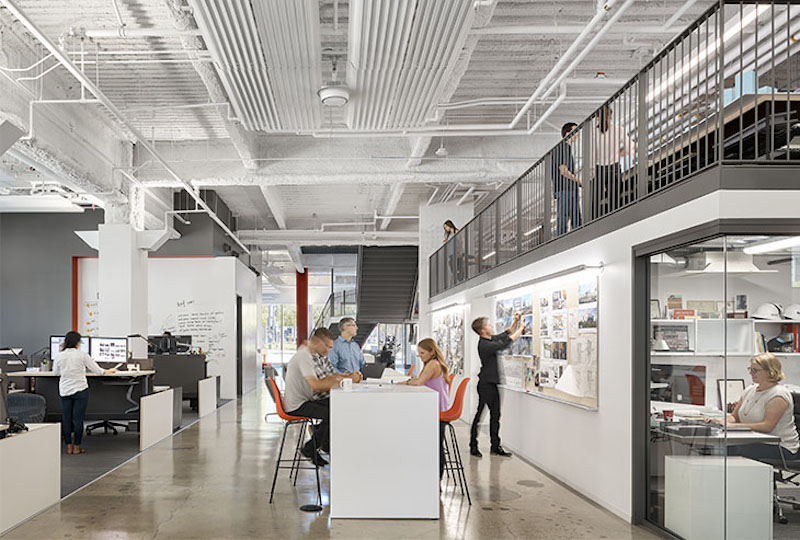Open plan offices have their fair share of supporters and detractors. In a recent Harvard study, researchers are calling their efficacy into question. The report measured the impact the open workspace has on communication and collaboration. Several media outlets have seized on this, grandly describing this work as “the first study to empirically measure both face-to-face and electronic interaction before and after the adoption of open office architecture” and wondered if this marks the end of the open office.
We think not.
The study reminds us that nuance matters, especially in design. No two employees or companies are exactly alike. It’s a good idea to remind ourselves of these individualities before jumping to any conclusions.
Gensler first entered this discussion a decade ago. Our 2016 U.S. Workplace Survey compared the effectiveness of a wide spectrum of space types: individual offices; shared offices; high-, medium-, and low-panel open spaces; and bench seating.
The results were striking. The degree of open or enclosed didn’t matter in high-performing work environments. If the space was designed to function well, all individual space types were rated as equally effective. An open plan can be just as effective as a private one. What matters is that design aligns with employees’ needs.
A company must invest in the individual and their experience to design an engaging workplace. How can we make that happen? These three key elements contribute to a meaningful workplace:
— Design: The design must be flexible because employees need choices. In fact, our Workplace Survey found that innovative companies offer their employees twice the amount of choices when and where to work than the less innovative counterparts. The ability to toggle back and forth between areas for collaboration and solo work makes an enormous difference.
— Noise Management: Offices that manage noise help employees feel like they are not being overheard by their peers. People stay engaged when quiet spaces are included in a layout. Bustle and energy can be great, but everyone needs a little solitude sometimes.
— Access: This may seem obvious, but the most productive employees need quick access to people and resources. From food to supplies, it’s important to include resources that are easily found so that people feel connected and well-supplied for success. Access to teams, decision-makers, and subject matter expertise is paramount to moving work quickly forward in business today.
Yet, communication is a constantly changing challenge. People are more connected to their devices than ever before. This issue follows us to work as well. Thoughtful design provides the right balance between collaborative and solo spaces so employees don’t feel overwhelmed or self-conscious.
Several lessons from our 2016 U.S. Workplace Survey bolster this perspective. First, most innovative companies tend to foster collaboration in places other than primary workspaces. Of those, 70 percent featured in-person collaboration in conference rooms, as opposed to only 60 percent of the least innovative set.
Likewise, 44 percent of the most innovative companies collaborated in open meeting areas, compared to only 26 percent of the least innovative. Again, innovators toggle back and forth between collaboration and solo work and make effective use of all kinds of spaces and places.
Lastly, only 17 percent of non-innovators report having choice in when and where to work. This is a pitfall for both open office plans and private offices: if an employee feels like they have no control, performance will suffer regardless of layout.
We live in an age of metrics. It makes sense to measure the success of a workplace by how much its employees communicate, but this metric alone is not enough. The workplace depends on many factors. When you have a well-designed space that works for both focus and collaboration, these pieces tend to fall far more easily into place. The open office is not dead, but a high-performing workspace is more than just an open plan.
More from Author
Gensler | Apr 15, 2024
3 ways the most innovative companies work differently
Gensler’s pre-pandemic workplace research reinforced that great workplace design drives creativity and innovation. Using six performance indicators, we're able to view workers’ perceptions of the quality of innovation, creativity, and leadership in an employee’s organization.
Gensler | Mar 13, 2024
Trends to watch shaping the future of ESG
Gensler’s Climate Action & Sustainability Services Leaders Anthony Brower, Juliette Morgan, and Kirsten Ritchie discuss trends shaping the future of environmental, social, and governance (ESG).
Gensler | Feb 15, 2024
5 things developers should know about mass timber
Gensler's Erik Barth, architect and regional design resilience leader, shares considerations for developers when looking at mass timber solutions.
Gensler | Jan 15, 2024
How to keep airports functional during construction
Gensler's aviation experts share new ideas about how to make the airport construction process better moving forward.
Gensler | Dec 18, 2023
The impacts of affordability, remote work, and personal safety on urban life
Data from Gensler's City Pulse Survey shows that although people are satisfied with their city's experience, it may not be enough.
Gensler | Nov 16, 2023
How inclusive design supports resilience and climate preparedness
Gail Napell, AIA, LEED AP BD+C, shares five tips and examples of inclusive design across a variety of building sectors.
Gensler | Oct 16, 2023
The impact of office-to-residential conversion on downtown areas
Gensler's Duanne Render looks at the incentives that could bring more office-to-residential conversions to life.
Gensler | Sep 13, 2023
Houston's first innovation district is established using adaptive reuse
Gensler's Vince Flickinger shares the firm's adaptive reuse of a Houston, Texas, department store-turned innovation hub.
Gensler | Aug 7, 2023
Building a better academic workplace
Gensler's David Craig and Melany Park show how agile, efficient workplaces bring university faculty and staff closer together while supporting individual needs.
Gensler | Jun 29, 2023
5 ways to rethink the future of multifamily development and design
The Gensler Research Institute’s investigation into the residential experience indicates a need for fresh perspectives on residential design and development, challenging norms, and raising the bar.

















